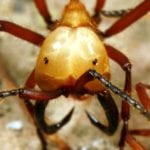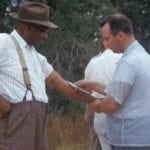 Mysteries
Mysteries  Mysteries
Mysteries  History
History 10 Surprising Stories About the Texas Rangers
 Humans
Humans 10 Philosophers Who Were Driven Mad by Their Own Theories
 Miscellaneous
Miscellaneous 10 Video-Game-Worthy Weapons and Armors from History
 Weird Stuff
Weird Stuff 10 Psychics Who Accurately Predicted Wartime Events
 The Arts
The Arts 10 Pieces of Art Inspired by a Broken Heart
 Health
Health 10 Science Fiction-Sounding New Medical Treatments
 History
History 10 Surprising Facts About the Father of Submarine Warfare
 Space
Space Ten Astonishing New Insights into Alien Worlds
 Weird Stuff
Weird Stuff 10 Bizarre Summer Solstice Rituals Still Practiced Today
 Mysteries
Mysteries Top 10 Haunting Facts About the Ghost Ship MV Alta
 History
History 10 Surprising Stories About the Texas Rangers
 Humans
Humans 10 Philosophers Who Were Driven Mad by Their Own Theories
Who's Behind Listverse?

Jamie Frater
Head Editor
Jamie founded Listverse due to an insatiable desire to share fascinating, obscure, and bizarre facts. He has been a guest speaker on numerous national radio and television stations and is a five time published author.
More About Us Miscellaneous
Miscellaneous 10 Video-Game-Worthy Weapons and Armors from History
 Weird Stuff
Weird Stuff 10 Psychics Who Accurately Predicted Wartime Events
 The Arts
The Arts 10 Pieces of Art Inspired by a Broken Heart
 Health
Health 10 Science Fiction-Sounding New Medical Treatments
 History
History 10 Surprising Facts About the Father of Submarine Warfare
 Space
Space Ten Astonishing New Insights into Alien Worlds
 Weird Stuff
Weird Stuff 10 Bizarre Summer Solstice Rituals Still Practiced Today
Another 10 Bizarre Medical Tales
From bizarre disorders to landmark operations, the medical world is overflowing with amazing tales, which always make for good reading. In the past I have written two lists of baffling medical cases. For today’s list I will, once again, regale you with 10 true, yet unbelievable, tales from the world of medicine that will surely astound you. As always, feel free to share your own unusual medical cases in the comments.

Phonagnosia is a very rare disorder characterized by the inability to recognize people through their voices. People with this disorder can engage in face-to-face conversation, but they have difficulty in communicating over the phone, because they cannot identify who they are speaking to, even if it’s someone they know. Most of the documented cases of phonagnosia were recorded in people with brain lesions following a brain injury or a stroke, but the January 2009 issue of the journal, Neuropsychologia, featured a case study of a woman who was said to be born with the disorder. According to the study, the 60-year-old woman, known as KH, has difficulty recognizing the voices of both familiar and famous persons, and also struggled in learning to recognize unfamiliar voices.
The University College of London’s Dr. Brad Duchaine, who co-authored the study, says: “Voice recognition may not seem as important as face recognition, given that failing to recognize someone in front of you can cause much more social anxiety than not recognizing them over the phone. Yet we rely on voice recognition in our day-to-day lives, to identify people on the phone or those speaking on the radio.” KH, who was aware of her problem from an early age, was reported to have worked around her disability by avoiding phone conversations, whenever possible. She answers only “scheduled” calls so that she will always know who is calling her, and gives variations of her name to her co-workers so that she can differentiate between them.
Additional Information: During the study, Dr. Duchaine and Lucia Garrido, members of the UCL Institute of Cognitive Neuroscience, used a series of tests to gauge KH’s ability to recognize faces, voices, vocal emotions, speech perception and music. KH did poorly in the voice recognition tests, but performed well on the other tests. She can still identify emotions from voices, and she also can recognize famous tunes (although she can’t identify who sang what) and discern different musical instruments. Additionally, MRI scans on KH’s brain shows no brain lesions in the regions controlling voice and auditory perceptions, and KH’s hearing tests within normal range.
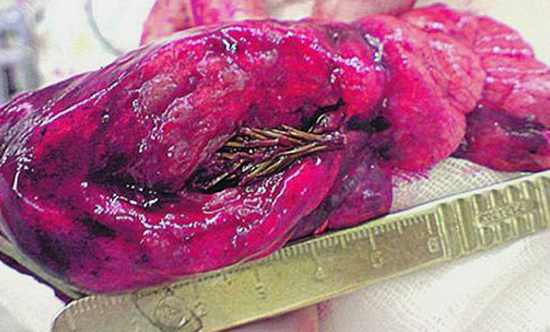
When 28-year old Artyom Sidorkin underwent surgery to remove a suspected cancerous tumor that was causing him extreme chest pain, medical staff in Izhevsk in the Urals, Russia, were startled to see a tiny tree growing inside Sidorkin’s lung. The five-centimeter fir tree branch was discovered when surgeon, Vladimir Kamashev, took part of the man’s lung for a biopsy. Dr. Kamashev recalled: “I thought I was hallucinating; I asked my assistant to have a look: ‘Come and see this — we’ve got a fir tree here.’ He nodded in shock. I blinked three times as I was sure I was seeing things.” Doctors think he might have inhaled a seed, which was deposited into his lung tissue. The seed sprouted there, and grew until it started touching capillaries in the tissue, causing Sidorkin extreme pain. The branch was later removed. “It was very painful. But to be honest, I did not feel any foreign object inside me,” said Sidorkin of his strange experience. “I’m so relieved it’s not cancer.”
Additional Information: This case mirrors that of a 2007 incident in which Chinese doctors operating on a ten-month-old girl with breathing problems found a blade of grass growing in her right lung.

When 64-year old Ashok Shivnani of Mumbai, India, was about to undergo an operation to remove a seven-centimeter-long tumor in his right kidney, doctors discovered that he had a rare congenital disorder called situs inversus. Shivnani’s organs were positioned back-to-front (i.e., the arrangement of his organs is a mirror image of that of a normal person). Shivnani’s echocardiogram revealed that his aorta and inferior vena cava (IVC) were reversed, as were most of his organs and blood vessels. “When I first saw the reports, I actually thought I was holding them wrong. Along with the reversed position of the aorta and IVC, the scans also showed that Shivnani had a second IVC coming out from the tumour-infected kidney, which joined the original IVC at the bottom of his abdomen. It would have been most difficult to proceed with the surgery under these circumstances,” said Dr Anoop Ramani, the surgeon who supervised Shivnani’s operation.
Additional Information: Although the doctors who examined Shivnani thought him to be the only living person with situs inversus, there are at least two more people in the world with documented cases of the condition. Randy Foye, an American basketball player, was found to have situs inversus, and Canadian actress Catherine O’Hara said in several interviews that her organs are reversed. People with situs inversus are usually asymptomatic, and they are often unaware of their unusual anatomy until they are examined by doctors.

Joanne Mackie, a 28-year old mother from Erdington, West Midlands, discovered, after giving birth to her first child, that she has a rare skin disease called Pemphigoid Gestationis, which makes her allergic to her own baby. Mackie developed serious rashes and painful blisters shortly after giving birth to her son, James. The welts in her skin were so excruciating that she could not hold her own baby and was forced to cover her arms with damp towels to protect them while she feeds him. The condition, which is said to affect one in 50,000 pregnancies, arises when antibodies that normally protect the placenta become confused and attack the skin, causing blisters to form.
“At first, when I was told I was allergic to my own baby I thought it was some sort of joke,” said Mackie. “But when it sank in I was totally devastated. It felt like my world had caved in. It was such a heartbreaking time. I had to watch while my husband gave our son his first bath. And in those first few weeks when James cried I had to watch as my husband picked him up to comfort him instead of me.” Fortunately, a month after doctors treated her allergy using strong steroids, Mackie finally was able to hold her baby without feeling any pain. “I have been told there is a 95 percent chance I will get this in my next pregnancy and this time the doctors say it could affect the baby. I am not sure I could put myself through it all again,” said Mackie. “But I have learned that a cuddle from your own child is the most precious thing in the world. Now I can cradle my little lad, it’s heaven. I never want to let him go.”
Additional Information: Pemphigoid gestationis often appears in pregnancy during the second or third trimester and/or immediately after birth. It is usually treated with a course of corticosteroids like prednisone.
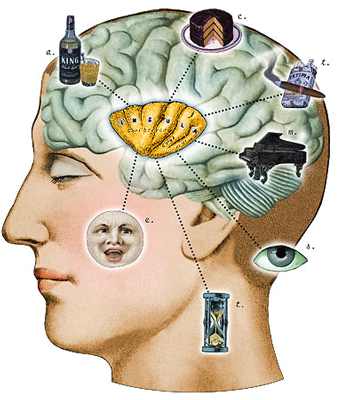
When Sandy Allen was diagnosed with a malignant brain tumor in her left temporal lobe, doctors saved her life by removing the tumor and part of her left brain. While she was recovering, she took art therapy sessions and began to have an intense passion for art. Because the left part of her brain, which is the analytical center of the brain and handles logic, was severely affected due to the surgery, the right side, which is said to be the emotional and creative center of the brain, started “taking over.” Experts believed that this is the reason for Allen’s sudden behavioral shift. As Allen jokingly puts it, “It’s like I’ve had my inhibitions surgically removed.” Her artistic impulses led her to turning her home into an art studio, its walls covered with colorful collages that she made herself.
Additional Information: There are various accounts of people, like Allen, who started displaying amazing artistic skills due to diseases affecting their brains. For example, painter Alison Silva saw a significant improvement in her painting ability when a non-life-threatening tumor started growing in her brain. Bizarrely, despite the migraines, insomnia, hallucinations, and the high risk of serious brain hemorrhaging, Silva decided to choose her career and opted not to have the tumor removed, despite her doctor’s misgivings.
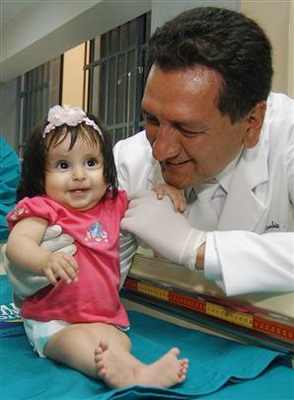
This item was briefly discussed in a previous list, but information was lacking so I made a more detailed report. On April 27, 2004, in Huancayo, Peru, Milagros Cerron was born with a rare congenital defect known as sirenomalia, which means that her legs were fused from the heels up to the groin, giving her the appearance of a mermaid. Along with this defect, Milagros has a deformed kidney, and her digestive, urinary and genital tracts share the same tube. The disorder is said to be so deadly that newborns with it usually die within two days after birth due to organ malfunctions.
Besides Milagros, there are only two other known cases of people who have lived with the condition past birth. But between 2005 and 2006, a team of doctors, led by Dr. Luis Rubio (from the Solidaridad hospital in Lima, Peru), had successfully carried out three operations to completely separate Milagros’ legs so that she could walk. The operations involved inserting silicone bags between the girl’s legs to stretch the skin connecting them, and later carefully slicing the skin to separate them. The surgery went so well that Milagros (whose name means ‘miracles’ in Spanish) was already walking several weeks later. Although pleased with her progress, Rubio warns that Milagros still needs further surgery to repair her various internal problems, not to mention several years of rehabilitation, before her condition can be considered stable.
Additional Information: There is only one other known survivor of sirenomelia still living today. Tiffany Yorks of the United States was born with the condition on May 7, 1988, and, like Milagros, she underwent a successful surgery to separate her legs . She is the oldest sirenomelia survivor to date.

Ines Ramirez Perez, a peasant living in Rio Talea, Mexico, is believed to be the only woman in the world who has performed a successful caesarian section on herself, and survived. In March 2000, Ines was alone in her cabin, pregnant with her eighth child, when she went into labor. After 12 hours of excruciating pain, the baby was still not coming out. Since the nearest midwife was over 50 miles away, Ines decided to take matters into her own hands and deliver the baby herself, despite having no medical training, whatsoever. While drinking a bottle of rubbing alcohol to numb the pain, Ines took a 15-centimeter kitchen knife, made a 17-centimeter incision in her abdomen, and pulled her baby out of her uterus by cutting its umbilical cord with a pair of scissors.
After the grisly, hour-long operation, she fainted. After she awoke, she covered her bleeding abdomen with clothes and told her 6-year old son to get help. Sixteen hours later, Ines was at the hospital where she underwent a couple of surgeries to treat complications that arose from her self-surgery. Amazingly, ten days after surgery, she was released from the hospital and was expected to make a full recovery. The baby boy, who was named Orlando Ruiz Ramirez, survived the ordeal and is completely healthy.
Additional Information: Ramirez commented on her experience: “I couldn’t stand the pain anymore. If my baby was going to die, then I decided I would have to die, too. But if he was going to grow up, I was going to see him grow up, and I was going to be with my child. I thought that God would save both our lives.” Her story proved to be so singular that it was outlined in the March, 2004, issue of the International Journal of Gynecology & Obstetrics.

Thomas Beatie, a married transgender man from Oregon, USA, attracted worldwide media attention when he decided to carry his second child, in his still-functioning womb, when his wife, Nancy, became infertile, due to a hysterectomy. Beatie, who was born a woman by the name of Tracy Lagondino, underwent gender reversal surgery and became a male legally, but has kept his female organs just in case he wants to be pregnant someday. Beatie wrote an article about his pregnancy in The Advocate, saying, “Sterilisation is not a requirement for sex reassignment, so I decided to have chest reconstruction and testosterone therapy but kept my reproductive rights. Wanting to have a biological child is neither a male nor female desire, but a human desire.” The pregnancy was successful, and Beatie gave birth to a baby girl on June 29, 2008. This was followed by two more successful pregnancies, both of which resulted in baby boys.
Additional Information: The impregnation of a transgender man is possible when the person still has functioning female reproductive organs, and can be done by interrupting hormone treatments. In Beatie’s case, he stopped taking testosterone injections, and it took about four months before Beatie’s body regulated itself and became fit for impregnation.

Dede Koswara, an Indonesian man in his late thirties, recently gained a lot of media exposure when he was found to have a rare hereditary skin disorder, known as Lewandowsky-Lutz dysplasia. The condition resulted in gnarled, scaly warts growing uncontrollably all over his body, especially around the hands and feet, thus earning him the nickname ‘The Tree Man.’ Koswara’s ordeal started when he cut his knee when he was fifteen. He was then infected with a strain of human papillomavirus (HPV), and, because of his underlying condition, growths called cutaneous horns began to spread all over his body.
Because of his disease, he left his job as a builder and fisherman and began working on a traveling freak show. Eventually, his wife of ten years left him, citing financial problems. Fortunately, after his case attracted widespread attention, donations from the public and the government started pouring in. He immediately received treatment, and after nine operations, more than eight kilograms of warts were removed from his body. This enabled Koswara to see the outlines of his hands and feet for the first time in about 20 years.
Additional Information: Lewandowsky-Lutz dysplasia (also known as Epidermodysplasia verruciformis) is a hereditary disorder linked with a high risk of skin carcinoma. Though the condition usually manifests when the sufferer is between 12 months and 20 years old, it sometimes can appear in middle age, as it did in the case of Dede Koswara.
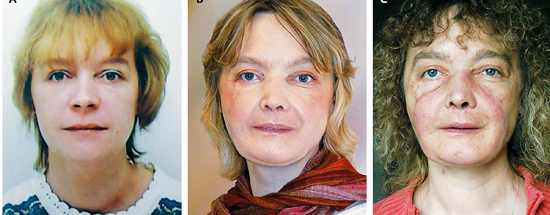
Isabelle Dinoire of Valenciennes, France, became the first person in the world to receive a partial face transplant. Surgeons repaired the 38-year-old woman’s face after it was disfigured from a dog attack. Led by Dr. Bernard Devauchelle, a team of doctors performed the operation on Dinoire on November 27, 2005, at the Centre Hospitalier Universitaire Nord in Amiens, France. The operation involved grafting a triangular piece of face tissue that contained a nose and a mouth to Dinoire’s damaged face. The tissue had been taken from a brain-dead female donor. After the surgery, to prevent rejection of the tissue, Dinoire was given bone marrow cells and suppressants. A couple of years later, though her appearance had significantly changed, Dinoire had gained sensitivity in her face and full control of her facial muscles.
Additional Information: According to most reports concerning Dinoire’s surgery, it is believed that her face was mutilated when she passed out from an overdose of sleeping pills and her pet Labrador began scratching and clawing Dinoire’s face in a frantic attempt to wake her up. The dog later was euthanized by order of Dinoire’s family.






